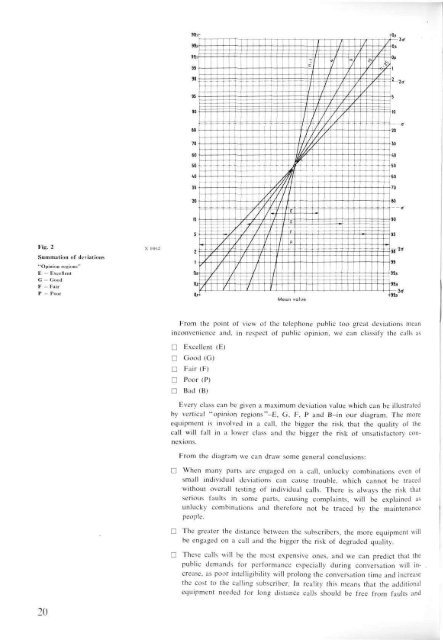1 - History of Ericsson - History of Ericsson
1 - History of Ericsson - History of Ericsson
1 - History of Ericsson - History of Ericsson
Create successful ePaper yourself
Turn your PDF publications into a flip-book with our unique Google optimized e-Paper software.
Fig. 2<br />
Summation <strong>of</strong> deviations<br />
"Opinion regions"<br />
E = Excellent<br />
G = Good<br />
F = Fair<br />
P = Poor<br />
20<br />
99-,<br />
99.5<br />
99<br />
98<br />
90<br />
80<br />
70<br />
50<br />
50<br />
20<br />
10<br />
5<br />
I<br />
03<br />
0.i<br />
-»-<br />
/: /L<br />
/<br />
A<br />
1<br />
/<br />
J<br />
L<br />
7 7<br />
/<br />
tv-<br />
/ —1<br />
/ i /<br />
/<br />
T<br />
/<br />
r<br />
1<br />
/<br />
1<br />
7<br />
\<br />
\<br />
\<br />
t<br />
\<br />
p<br />
—<br />
_j<br />
-1<br />
/<br />
c /<br />
;<br />
i<br />
/<br />
/<br />
/<br />
'<br />
—i—j. -<br />
Mean value<br />
j<br />
/<br />
/<br />
/ r<br />
i~i<br />
i<br />
i<br />
i<br />
-4-1<br />
—w<br />
/<br />
1 /<br />
-r-<br />
/<br />
•<br />
y<br />
'/<br />
/<br />
/<br />
/<br />
/<br />
/<br />
'<br />
/<br />
r<br />
-»<br />
/<br />
J<br />
-/<br />
/<br />
—-<br />
" • ' ,<br />
..:t_2tf<br />
From the point <strong>of</strong> view <strong>of</strong> the telephone public too great deviations mean<br />
inconvenience and, in respect <strong>of</strong> public opinion, we can classify the calls as<br />
• Excellent (E)<br />
• Good (G)<br />
• Fair (F)<br />
• Poor (P)<br />
• Bad (Bj<br />
Every class can be given a maximum deviation value which can be illustrated<br />
by vertical "opinion regions"-E, G, F, P and B-in our diagram. The more<br />
equipment is involved in a call, the bigger the risk that the quality <strong>of</strong> the<br />
call will fall in a lower class and the bigger the risk <strong>of</strong> unsatisfactory connexions.<br />
From the diagram we can draw some general conclusions:<br />
• When many parts are engaged on a call, unlucky combinations even <strong>of</strong><br />
small individual deviations can cause trouble, which cannot be traced<br />
without overall testing <strong>of</strong> individual calls. There is always the risk that<br />
serious faults in some parts, causing complaints, will be explained as<br />
unlucky combinations and therefore not be traced by the maintenance<br />
people.<br />
• The greater the distance between the subscribers, the more equipment will<br />
be engaged on a call and the bigger the risk <strong>of</strong> degraded quality.<br />
• These calls will be the most expensive ones, and we can predict that the<br />
public demands for performance especially during conversation will increase,<br />
as poor intelligibility will prolong the conversation time and increase<br />
the cost to the calling subscriber. In reality this means that the additional<br />
equipment needed for long distance calls should be free from faults and<br />
— 10<br />
--50<br />
.<br />
— 90<br />
—95<br />
499a
















